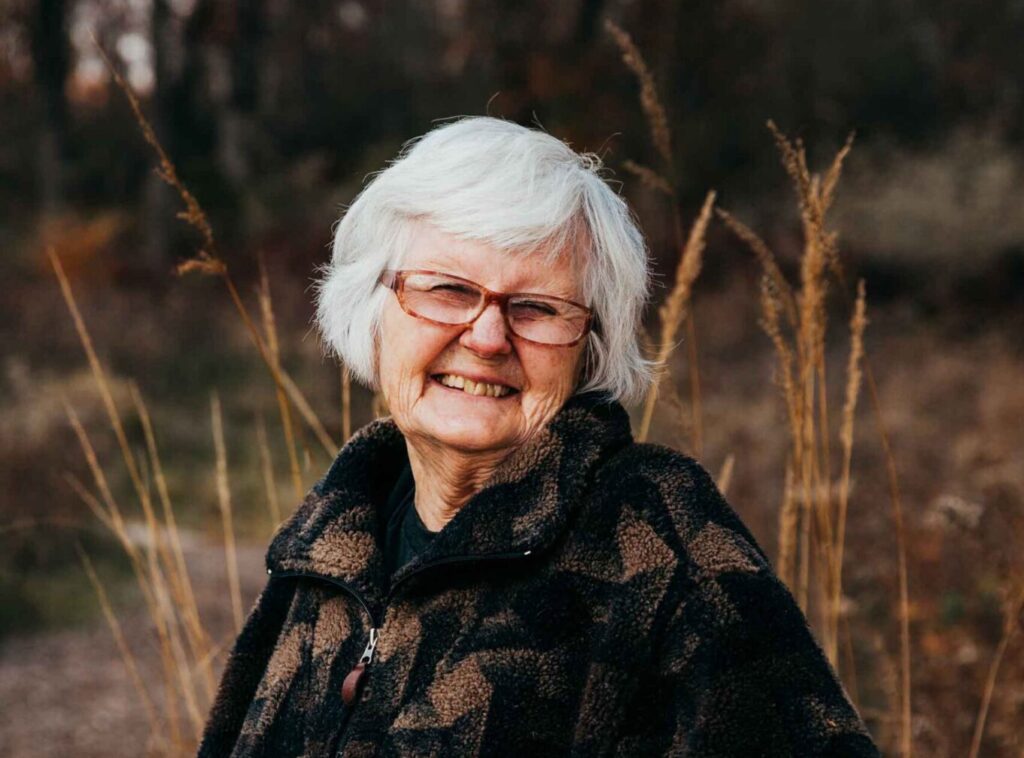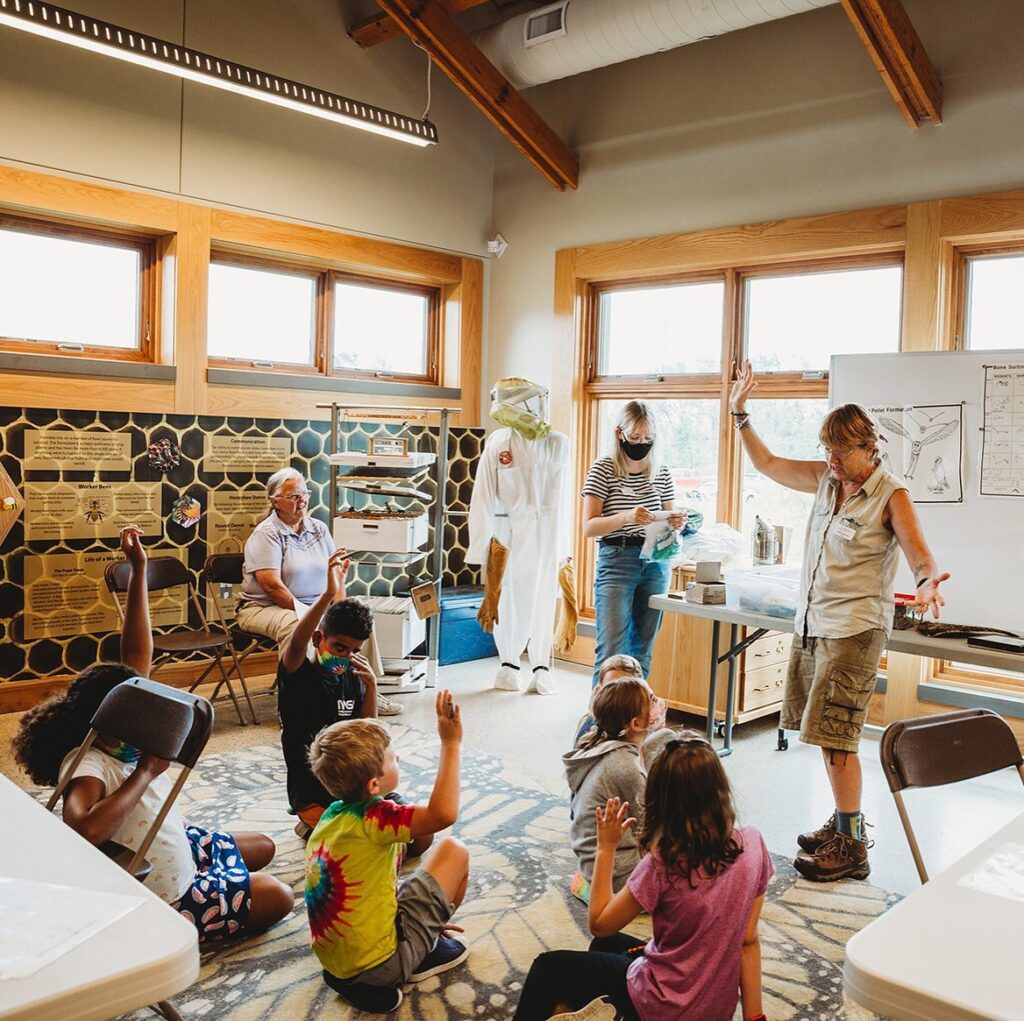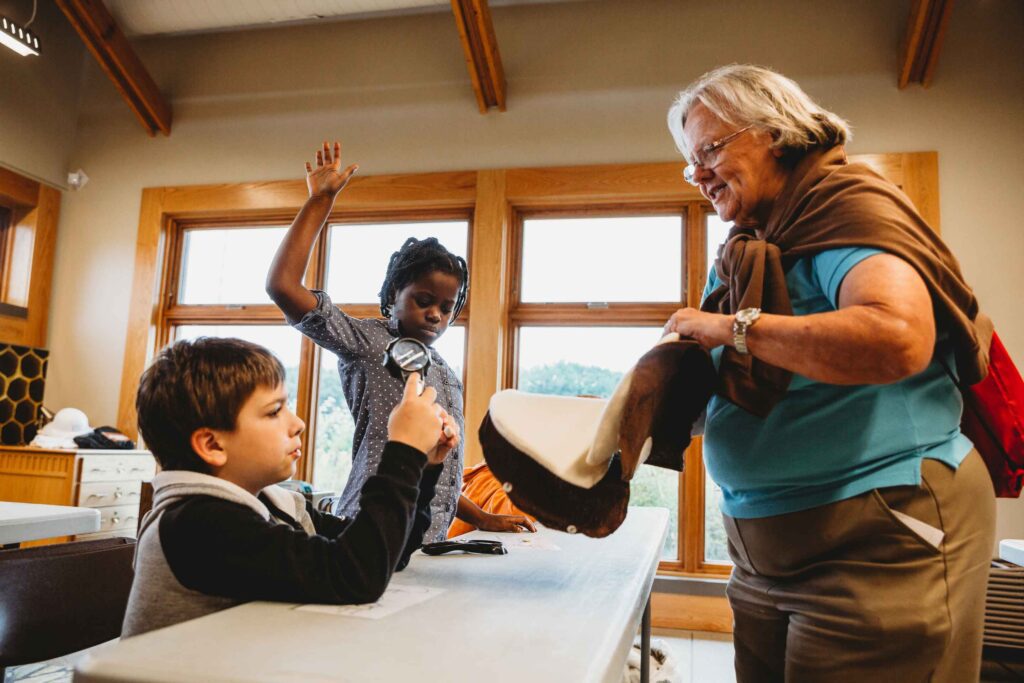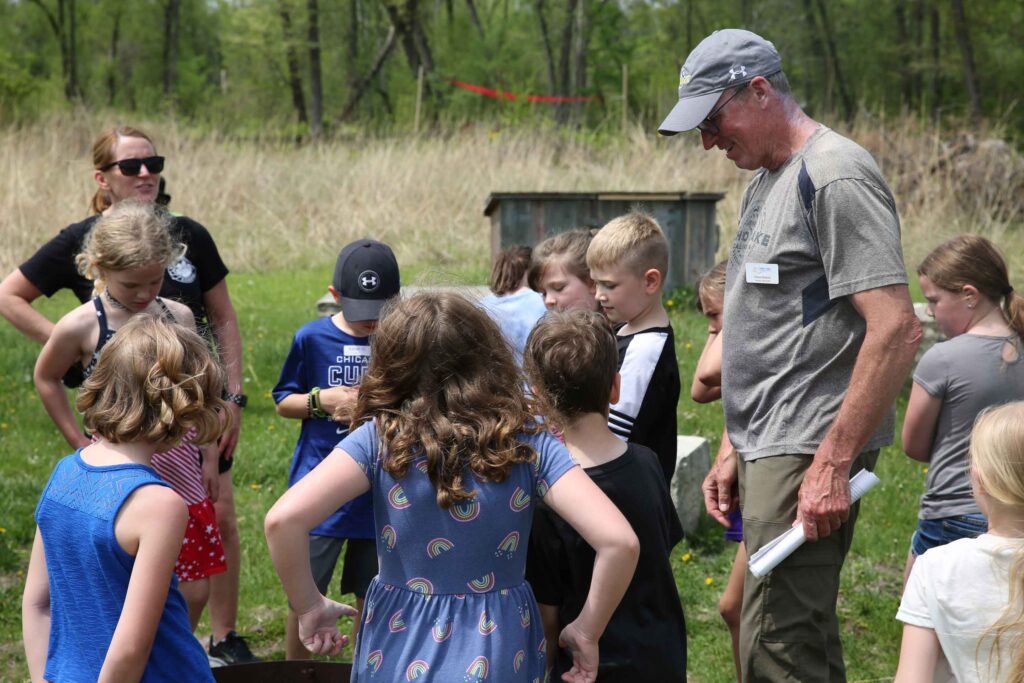Dorothy “Dot” Hinman has been a part of the Indian Creek Nature Center family since its founding. Over the years she has volunteered in various capacities — with and without her husband, Gene (deceased). Dot became a lifetime member in 2018, and continues to enjoy visits to the Nature Center when she can. “Some of the happiest memories of our family (husband Gene, sons Dave and Jim) involved walking there (at the Nature Center) year round or enjoying events like the Maple Syrup Festival.”
From the Winter 1974 issue of the Indian Creek Nature Center newsletter: Six people have successfully completed the initial four-week training for volunteer Teacher-Naturalists. All are equipped with the knowledge and skills to conduct activities for visiting school classes. Each person is dedicating one-half day per week to lead and coordinate field trips for these school classes. Qualifications which individuals in the group have range from a Masters degree in Environmental Education to having a “natural interest.” Full-fledged Teacher-Naturalists are: Dorothy Hinman, Marian Karrar, Margo MacKay, Nancy Owen and Connie Rammelsberg. Barbara Binhammer (now Barbara Perkinson) is the Teacher-Naturalist coordinator.
This is Dot’s first-person account of early days with the Nature Center, as a member of the first team of Teacher-Naturalists working with children from the schools.
“We (the first group chosen) were so excited about the plans, and the tremendous potential for reaching new children and families in nature and its delights. Dr. Rob Drexler, biology professor at Coe College, agreed to mentor us, and we started in the winter, learning about trees first, then birds, animals of the area, and then as the weather warmed, plants we’d see. The most difficult part of the training for me was the snake circle. We sat in a circle and the trainer talked about Iowa snakes with examples she had with her. Then it was our turn to pass the snakes around and get comfortable handling them, since we might need to catch one. I was one of the first to get experience, as I discovered a small garter snake sunning in the morning on the bridge and was able to catch it — a small miracle — and show the students and let them touch it.
“At the time we enlisted, the barn still had stanchions in the lower level. The upper level was to become the main meeting room, and stairs were built next to the silo. When the bus arrived, dozens of youngsters came upstairs — some excited, others wary — as they tried to guess what might happen during the day. There was a session in the pasture and woods, a return to the commons for lunch, and then an afternoon session on the creek.
“At this time, the property of the Nature Center had been a big pasture (bluegrass) from the road to the woods. The tree border we now see between creek and prairie was then mostly scrub with small trees. At least one beaver family had been very busy working on available trees, and it was easy to point out gnawed trees as students walked anywhere near the creek. The trees from the woods were smaller, of course, than they are now, and a small planted pine grove up in the woods was the hangout of several owls.
“Because the only bridge was the one on the road, we carefully walked students across the bridge and then down the path along the small trees/bushes into the pasture with ankle-deep grass. This was usually our first stop, sitting on the grass, talking about who might live in the pasture, finding that the grass usually had many tunnels through it, made by mice and voles. Circling hawks were often present, providing a great opportunity to talk about those amazing birds who folded their wings and dove toward prey with incredible speed. I remember one day when we talked about a circling hawk, guessed what it might be looking for, and as I explained about the stoop, it did just that, diving into the pasture at the end of the open area, finding its prey, which it promptly devoured.
“Teaching opportunities were everywhere, and class time was loosely scheduled to take advantage of whatever we found — a bird impaled on a thorn by a kingbird who stored its meal for later, a rub on a tree where a deer had rubbed off its velvet covering, evidence of beaver dragging a branch to the creek.
“The walk through the woods was filled with so many great places to explore. The biggest old cottonwood had to be admired, with arms stretched around, old logs were turned over to see inhabitants with lots of learning, and the pine grove was fun to explore to see if we could find owl pellets. Each day was different. We had general plans to talk about differences between places, value of “edge” as well as places we thought might be found, differences of trees and plants we’d see in one place and not in another. But opportunity trumped lesson plans.
“Our usual classes — 5th graders, I think — varied by teacher choice. I remember a group of high school students from the alternative high school were really a challenge, but it was amazing to get them to talk about their experiences. I will always remember the haikus that they wrote while sitting on the grass in the pasture, because their experiences were so different from those of younger students. I especially remember one student who sat in this beautiful, peaceful meadow and wrote a haiku about the sound of a police siren in the distance.
“Another time we had a blind student with us, and we took turns blindfolding one of a pair and then having the “blind” student describe various settings, a big tree, the meadow, the sounds we heard. It was a learning experience for all of us: who had ever paid so much attention to the feel of the bark on two different trees? On another trip I had a little girl take me by the hand as we walked across the bridge and tell me she had never walked in grass before. Her home and school were surrounded by concrete or dirt. She was afraid there were animals in there that would hurt her.
“With the woods relatively untouched by people, we found more animals than are seen now. Deer were frequently seen in the woods if you were walking quietly. There was an active fox den in a ravine in the western part of the woods, and a number of people were lucky enough to see either adults or kits. The active beaver den working the creek not only provided chew marks on most trees as well as stumps. I had a very memorable solitary winter morning walk on what is now the Sac and Fox Trail along the creek. It was a frosty morning and as I walked close to the creek I noticed a clump of grass with heavy frost, looking different from its surroundings. As I looked more closely I noted it was next to a six-inch hole. I checked with the naturalist, who confirmed that it was the escape hole for the beaver den. Really neat!
“Our experiences with the groups of children were each different, and I learned as much as the children. There were lots of great books in the commons in the barn, so if we found something we couldn’t identify, it went back with us to look it up.
“It was so hard when I needed to take a full-time job and could no longer serve as a Teacher-Naturalist. But weekend family trips to the Nature Center brought us there often, with annual family memberships. Time spent there brought so much joy to us all. It also was such fun to see the barn transformed from its dairy home into great usable space, and opportunities grew each year, adding the museum and store, and more classroom ideas. Even then it was an amazing space.”




